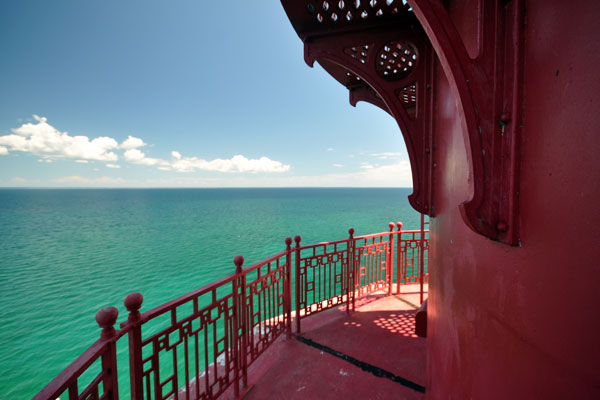With the opening of the Erie Canal to Buffalo in 1825,
westbound expansion on the Great Lakes increased exponentially. The dangers
represented by Waugoshance Shoal which lurked off the western entry to the
Straits likewise represented an increasing threat to mariners threading their
way through the area.
 |
| The opening of the Erie Canal in 1825 had an incredible impact on western expansion through the Great Lakes |
Responding to a cry from the maritime community, Congress
passed an appropriation of $10,000 to build a lightship to mark the shoal on
March 3, 1831. Bids for construction of the vessel were advertised in maritime
newspapers that May, and the Detroit shipyard of Oliver Newberry was selected
to build the vessel after the closing of bids in July. The workers at
Newberry’s yard began construction soon thereafter. While no plans of the
vessel have surfaced to this time, bid specifications from the May 12, 1831 issue
of The Detroit Courier provide us with a fair idea of the vessel’s dimensions
and how she must have appeared:
With a hull of white oak clad in copper, the vessel stood
46’ long between the perpendiculars*, had a keel length of 36’ and a beam of
17’ 9”. Her large trunk cabin was built
up through the deck to provide sufficient headroom for a crew of six men, and
was outfitted with berths, lockers and a galley. The vessel’s twin masts
consisted of 42’ long yellow pine square timbers mounted parallel to each other
in a fore and aft orientation. Mounted on a wheeled carriage, the ship’s
all-important lantern rode vertically on wheels against the inner surfaces of
these two masts. Ropes attached to the carriage passed over pulleys at the top
of each mast, and were fastened to counterweights which passed down grooves in
the sides of the mast, allowing for simple and fast raising and lowering of the
lantern for maintenance. Attached to the aft mast of this pair, a single
trysail mast served to power the vessel to and from her station.
 |
| This model of the Louis McLane was built to reflect the original written specifications |
A mooring ringbolt, formed from 1¼-inch diameter iron, was
sturdily attached to the vessel’s keel at the bow and served to attach sixty
fathoms of 7/8-inch chain to an 800-pound mushroom anchor in order to anchor
the vessel at her station. To serve the vessel during fog and thick weather, a
manually-operated four hundred-pound bell was also suspended in a small belfry
on deck.
 |
| The vessel was moored to a mushroom anchor similar to that above |
Completed at a final cost of $7,350.00, the vessel was
likely completed prior to May 1, 1832 in accordance with the contract
requirement. Christened “Louis McLane” in honor of the Secretary of the
Treasury at the time, she was likely towed to the Straits and placed on her
station off Waugoshance Shoal on an unspecified date later that year.
 |
| The vessel was named Louis McLane who was serving as Secretary of the Treasury |
Typical of the problems encountered by the vessel was the
situation reported by Lieutenant James T. Homans on his visit to The Straits
during his 1838 inspection of lighthouses of the Western Great Lakes. In his
report to the Fifth Auditor of the Treasury, Homans stated that on his arrival
in Mackinaw he found the lightship had been under repair in the harbor since
being thrown on a beach after being torn from her anchorage during the 1837
navigation season. Finally returned to her station on the 20th of September
1838, she was again driven off a few short weeks later, leaving the deadly
shoal at Waugoshance unmarked for almost a full year.
 |
| The approximate location where the Louis MacLane was anchored |
Homans was succinct in his assessment of the situation,
stating “I am satisfied she is very unfit for that location; and she can be
usefully employed near the flats of Lake St Clair, where the shelter is good, I
would strongly recommend that another one be immediately built upon a more
approved model for the Straits so as to be ready for removal there on the
opening of navigation in the spring.”
With typical Pleasonton-era foot-dragging, no move was taken
to replace the vessel until 1844, when, according to entries in Light Lists,
she was superseeded by a larger 101-ton vessel. However, history shows that no
lightship was placed on Lake St. Clair until 1887, when LV-10 was placed off
Grosse Point to mark the eastern entrance to the Detroit River. As such, it is
clear that the Louis McLane was not reassigned to St. Clair in accordance with
Homans' suggestion, and we have yet to uncover any records indicating the old
vessel’s final disposition.
 |
| Stephen Pleasonton - Fifth Auditor of the Treasury, and the man responsible for US lighthouses in 1832 |
With the construction of the permanent lighthouse on
Waugoshance Shoal in 1851, itself the proud holder of numerous “firsts”, the
services of a lightship were no longer needed to mark the shoal. While numerous
stalwart lightships would be subsequently deployed throughout the Great Lakes,
the Louis McLane stands alone as the first to be so employed 180 years ago this
year.
 |
| The LOUIS MCLANE served until erection of the Waugoshance light station in 1851 |
Article written by Terry Pepper, and first published in the Fall 2007 issue of the GLLKA BEACON


















































